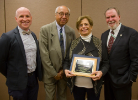National planning conference sets records in Buffalo
Published November 20, 2018 This content is archived.
The Association of Collegiate Schools of Planning set an attendance record for its national conference when more than 1,200 urban planning scholars descended on Buffalo last month for ACSP 2018.
The conference, which took place Oct. 26-28, brought together urban planning faculty, scholars and students from more than 100 colleges and universities from across the U.S. and Canada to share research on the discipline's most pressing questions.
UB's Department of Urban and Regional Planning served as local host for the conference, which was shaped around the theme of long-term urban resurgence and its relationship to equity, economic development, sustainability, housing, transportation and land use.
Leadership from the department and School of Architecture and Planning played a pivotal role in recruiting the ACSP to Buffalo for its 2018 conference. The last time ACSP held its conference here was 1988.
Daniel B. Hess, professor and chair of urban planning at UB, said the conference put Buffalo and its transformation on center stage, and drew attention to the city as an ideal site of study for issues in urban planning.
“We were especially proud to show off Buffalo to our colleagues, particularly the city's vibrant neighborhoods, revitalized urban core, and diverse immigrant communities," said Hess. "Much has changed since the ACSP came to Buffalo 30 years ago; our visitors surely saw a ‘new’ place in 2018.”
In addition to presenting their research at the conference, UB's urban planning faculty and students added a Buffalo and UB flair to a number of events and programs:
- More than two dozen participants came to Buffalo a day early to participate in the "What's Next for Buffalo Niagara?" workshop. Organized by research professor Bradshaw Hovey, the day-long workshop convened national experts with local stakeholders to consider the long-range future of Buffalo. (Read more about results of the workshop).
- Food systems planning scholars joined a special pre-conference workshop organized by UB urban planning professor Samina Raja and her Food Systems Planning and Healthy Communities Lab (Food Lab) to consider the relationship of food systems to equity and social justice.
- Several "local host sessions" featured the work of research centers at the School of Architecture and Planning, including the Center for Urban Studies, the UB Regional Institute and the Food Lab.
- UB urban planning faculty organized the ACSP Pre-Doctoral Workshop to expose students from under-represented minority groups to doctoral study in urban planning. The event was organized by Zoe Hamstead, assistant professor of urban planning, along with Daniel Hess.
- More than 50 urban planning student volunteers provided logistical and programmatic support throughout the event, from managing the welcome desk and greeting visitors to leading tours and workshops. Their efforts were organized by Camden Miller, a student in UB's urban planning PhD program.
- A series of "mobile workshops" toured conference-goers around the city (some by bicycle). Faculty and student docents led six themed tours that highlighted the city's assets, including historic preservation, its monumental grain elevators, new industry, African-American history and culture, the West Side of Buffalo and transportation. Student volunteers took the school's Instagram followers along with them through a "takeover" of the school's social media channel, where they shared photos and commentary.
- Ibrahim "Himi" Jammal was recognized posthumously for his leadership in international planning education by the ACSP's Global Planning Educators Interest Group. Jammal was one of the school's first faculty members and founder of its urban planning program. The award was presented to Jammal's wife, Viviane Jammal, at the conference.












